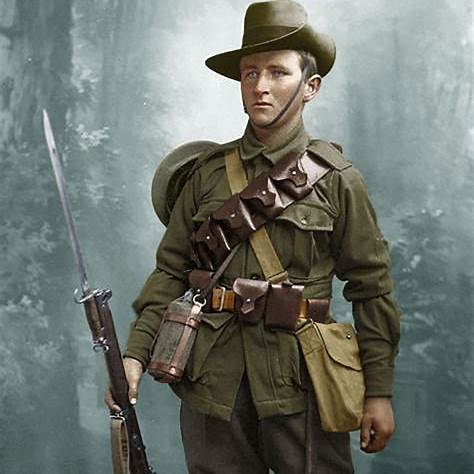
WWI Uniform History & Development: Evolution of Military Attire
Published on Mar 10, 2025
Introduction
World War I (1914–1918) marked a significant turning point in military history in terms of tactics and technology and the evolution of military uniforms. The war prompted a departure from the ornate and colourful uniforms of the 19th century to more practical and subdued attire. This transformation was driven by the brutal realities of modern warfare, where visibility on the battlefield could mean the difference between life and death.
The Pre-War Uniform Landscape
Before the outbreak of World War I, many European armies adorned their soldiers in bright and elaborate uniforms, reflecting centuries-old traditions and a desire to display national pride. These uniforms were often more ceremonial than practical, designed to stand out on the battlefield.
- Germany: The German Imperial Army traditionally wore Prussian blue tunics. However, in 1907, they introduced the field-grey (Feldgrau) uniform, aiming for a more practical and less conspicuous attire. This shift was part of a broader move towards functionality in military dress.
- United Kingdom: The British Army transitioned from the iconic red coats to khaki uniforms following experiences in earlier conflicts like the Second Boer War. The khaki Service Dress, introduced in the early 1900s, was designed to provide better concealment and practicality in various terrains.
- France: French soldiers entered World War I wearing blue coats and red trousers, known as "pantalon rouge." Despite the conspicuousness of this attire, there was significant resistance to change due to national pride and traditionalism.
The Push for Camouflage and Practicality
The devastating casualties in the early months of World War I underscored the need for uniforms that offered better concealment and protection. The static nature of trench warfare and the widespread use of artillery made soldiers acutely aware of the dangers of being easily spotted.
- Germany: The German Army's adoption of the Feldgrau uniform before the war proved advantageous. The grey-green colour provided a degree of camouflage in the varied European landscapes, aligning with the increasing emphasis on stealth and protection.
- United Kingdom: The British Service Dress was practical and less conspicuous than previous uniforms. However, as the war progressed, modifications were made to enhance functionality, such as introducing the soft "Gor Blimey" cap, which could be worn under helmets or stuffed into pockets.
- France: The French Army faced heavy casualties partly due to their highly visible uniforms. Recognizing the need for change, they introduced the "horizon blue" uniform in 1915, a light blue-grey attire that provided better concealment. Additionally, France was the first to introduce steel helmets (the Adrian helmet) to protect soldiers from shrapnel and debris.
Manufacturing and Supply Challenges
The mass mobilization during World War I created unprecedented demand for military uniforms, leading to significant manufacturing and supply challenges.
- Germany: The rapid expansion of the German Army necessitated efficient production methods. Numerous factories, including textile mills and workshops, were repurposed or established to meet the demand for Feldgrau uniforms. Women played a crucial role in this effort, stepping into manufacturing roles as men went to the front lines.
- United Kingdom: In Britain, the surge of volunteers responding to Lord Kitchener's call led to shortages in standard khaki fabric. This shortage resulted in temporarily issuing dark blue uniforms, known as "Kitchener's Blues," during basic training. The blue colour arose because the original khaki dye had been produced in Germany before the war, and alternative sources were initially difficult to acquire.
- France: The French textile industry faced the challenge of rapidly producing the new Horizon blue uniforms. The transition required retooling factories and securing new dye sources, especially since the traditional red dye for the Pantalon rouge was no longer obtainable due to trade disruptions with Germany.
Impact of Uniform Changes on Soldier Morale and Identity
Uniforms have always been a significant aspect of military identity and pride. The changes during World War I had varied impacts on soldier morale.
- Germany: The Feldgrau uniform became a symbol of modern military efficiency. Its practicality was appreciated by the soldiers, reinforcing a sense of preparedness and adaptability to modern warfare.
- United Kingdom: The shift to khaki and the introducing of more practical attire were generally well-received. Soldiers valued the functionality of their uniforms, which contributed positively to morale.
- France: The move away from the traditional pantalon rouge was met with mixed feelings. While the new Horizon blue uniforms were more practical, some soldiers and segments of the public felt a sense of loss, as the red trousers had been a longstanding symbol of French military pride. However, the improved safety and functionality eventually led to broader acceptance.
Conclusion
World War I was a catalyst for significant changes in military uniforms, driven by the harsh realities of modern warfare. The transition from bright, conspicuous attire to more subdued and practical designs reflected a broader shift towards functionality and soldier protection. These changes improved battlefield effectiveness and marked a departure from traditionalism, influencing military uniform design in the decades to follow.
